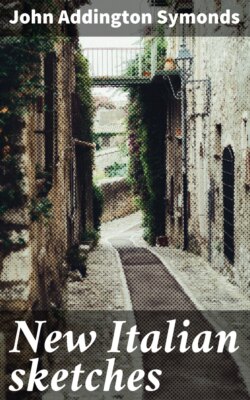Читать книгу New Italian sketches - John Addington Symonds - Страница 13
На сайте Литреса книга снята с продажи.
I.
ОглавлениеTable of Contents
In former days the traveller had choice of two old hostelries in the chief street of Siena. Here, if he was fortunate, he might secure a prophet's chamber, with a view across tiled house-roofs to the distant Tuscan champaign—glimpses of russet field and olive-garden framed by jutting city walls, which in some measure compensated for much discomfort. He now betakes himself to the more modern Albergo di Siena, overlooking the public promenade La Lizza. Horse-chestnuts and acacias make a pleasant foreground to a prospect of considerable extent. The front of the house is turned toward Belcaro and the mountains between Grosseto and Volterra. Sideways its windows command the brown bulk of San Domenico, and the Duomo, set like a marble coronet upon the forehead of the town. When we arrived there one October afternoon the sun was setting amid flying clouds and watery yellow spaces of pure sky, with a wind blowing soft and humid from the sea. Long after he had sunk below the hills, a fading chord of golden and rose-coloured tints burned on the city. The cathedral bell-tower was glistening with recent rain, and we could see right through its lancet windows to the clear blue heavens beyond. Then, as the day descended into evening, the autumn trees assumed that wonderful effect of luminousness self-evolved, and the red brick walls that crimson after-glow, which Tuscan twilight takes from singular transparency of atmosphere.
It is hardly possible to define the specific character of each Italian city, assigning its proper share to natural circumstances, to the temper of the population, and to the monuments of art in which these elements of nature and of human qualities are blended. The fusion is too delicate and subtle for complete analysis; and the total effect in each particular case may best be compared to that impressed on us by a strong personality, making itself felt in the minutest details. Climate, situation, ethnological conditions, the political vicissitudes of past ages, the bias of the people to certain industries and occupations, the emergence of distinguished men at critical epochs, have all contributed their quota to the composition of an individuality which abides long after the locality has lost its ancient vigour.
Since the year 1557, when Gian Giacomo de' Medici laid the country of Siena waste, levelled her luxurious suburbs, and delivered her famine-stricken citizens to the tyranny of the Grand Duke Cosimo, this town has gone on dreaming in suspended decadence. Yet the epithet which was given to her in her days of glory, the title of "Fair Soft Siena," still describes the city. She claims it by right of the gentle manners, joyous but sedate, of her inhabitants, by the grace of their pure Tuscan speech, and by the unique delicacy of her architecture. Those palaces of brick, with finely-moulded lancet windows, and the lovely use of sculptured marbles in pilastered colonnades, are fit abodes for the nobles who reared them five centuries ago, of whose refined and costly living we read in the pages of Dante or of Folgore da San Gemignano. And though the necessities of modern life, the decay of wealth, the dwindling of old aristocracy, and the absorption of what was once an independent state in the Italian nation, have obliterated that large signorial splendour of the Middle Ages, we feel that the modern Sienese are not unworthy of their courteous ancestry.
Superficially, much of the present charm of Siena consists in the soft opening valleys, the glimpses of long blue hills and fertile country-side, framed by irregular brown houses stretching along the slopes on which the town is built, and losing themselves abruptly in olive fields and orchards. This element of beauty, which brings the city into immediate relation with the country, is indeed not peculiar to Siena. We find it in Perugia, in Assisi, in Montepulciano, in nearly all the hill towns of Umbria and Tuscany. But their landscape is often tragic and austere, while this is always suave. City and country blend here in delightful amity. Neither yields that sense of aloofness which stirs melancholy.
The most charming district in the immediate neighbourhood of Siena lies westward, near Belcaro, a villa high up on a hill. It is a region of deep lanes and golden-green oak-woods, with cypresses and stone-pines, and little streams in all directions flowing over the brown sandstone. The country is like some parts of rural England—Devonshire or Sussex. Not only is the sandstone here, as there, broken into deep gullies; but the vegetation is much the same. Tufted spleen-wort, primroses, and broom tangle the hedges under boughs of hornbeam and sweet-chestnut. This is the landscape which the two sixteenth century novelists of Siena, Fortini and Sermini, so lovingly depicted in their tales. Of literature absorbing in itself the specific character of a country, and conveying it to the reader less by description than by sustained quality of style, I know none to surpass Fortini's sketches. The prospect from Belcaro is one of the finest to be seen in Tuscany. The villa stands at a considerable elevation, and commands an immense extent of hill and dale. Nowhere, except Maremma-wards, a level plain. The Tuscan mountains, from Monte Amiata westward to Volterra, round Valdelsa, down to Montepulciano and Radicofani, with their innumerable windings and intricacies of descending valleys, are dappled with light and shade from flying storm-clouds, sunshine here and there cloud-shadows. Girdling the villa stands a grove of ilex-trees, cut so as to embrace its high-built walls with dark continuous green. In the courtyard are lemon-trees and pomegranates laden with fruit. From a terrace on the roof the whole wide view is seen; and here upon a parapet, from which we leaned one autumn afternoon, my friend discovered this graffito: "E vidi e piansi il fato amaro!"—"I gazed, and gazing, wept the bitterness of fate."
